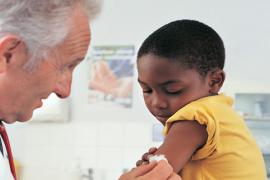Did you know that two out of every three adults have experienced at least one adverse childhood event (ACE) by the time they reach 18 years of age? In addition, one in eight adults reports experiencing four or more ACEs by age 18 (CDC, 2018). What are ACEs? They include experiencing emotional, sexual, and/or physical abuse; chronically feeling unloved or unwanted; the divorce or separation of one’s care-givers; and living with substance abuse or other mental health issues in the home.
Given the prevalence of ACEs, imagine what this implies about your campers and staff. Indeed, some will come to camp with ACE backgrounds. But why be concerned about that? Because ACEs have the potential to impact our interaction with others as well as our physical health (Harris, 2014; Jackson, 2016). That impact, a public health concern because of its prevalence, is illustrated by “Nellie’s Gift." It colors the camp experience for some people.
Because of the impact to physical and mental, emotional, and social health (MESH) well-being, ACEs are said to be trauma events. When faced with trauma, people either effectively cope with it and become more resilient, or they’re overwhelmed and ineffectively respond to the situation. Their response is often a function of the individual’s coping skills and available resources. Interestingly, youth — our campers — are still in the process of developing their coping abilities. Without caring adults to coach and encourage these abilities, they may get stuck or ineffectively respond, triggering a trauma response.
The prevalence of ACEs is generating considerable attention. There are now trauma-informed schools and trauma-informed practices. I believe it’s time our camps become trauma-informed too. That means not only understanding the prevalence of trauma — a topic that Jackson’s less-than-ten-minute YouTube presentation can wonderfully deliver (2016) — but also recognizing that trauma histories will arrive with some campers and staff, and those histories have the potential to color the camp experience. Being trauma-informed also means assessing camp practices to determine their potential to trigger trauma responses, the kind of thing “Nellie’s Gift” so aptly demonstrates, and adjusting practices to be more trauma-sensitive.
How might you make this happen?
First, get informed (refer to the References list as a starting point). Then raise awareness among your staff. Consider, for example, inserting Jackson’s (2016) YouTube video into the training for leadership staff, especially those who supervise other staff, as well as staff in general. Seed this experience with a question: “How does this information impact the work we do with campers/staff?” Given the nature of the resulting discussion, readily acknowledge that some staff may have ACEs in their personal history. Your intent is not to call attention to their experience, but rather acknowledge these events and discuss how staff might be supportive to people with trauma backgrounds. This complements the boundary-setting that’s also part of Mental Health First Aid, a training that’s becoming more common for camp staff.
Give your staff guidelines that complement your camp’s trauma-informed practices. The following suggested guidelines are drawn from trauma-informed schools’ literature (George Fox University, 2018; Milwaukee Public Schools, 2017) and include:
- Strive to understand youth development and support campers as they accomplish age-appropriate tasks.
- Maintain the capacity and skills to be supportive.
- Shape your relationship with campers so it builds connectedness.
- Shift your perspective from “What’s wrong with you?” to “What do you need?”
- Empower both yourself and campers to appropriately address issues and, as a result, become more resilient.
In addition to becoming informed, audit your camp’s practices to determine its trauma sensitivity. Learning what’s already a natural support to people with trauma backgrounds empowers one to do even more. Learning what camp practices may trigger trauma allows you to make changes, even if those changes take time to fully integrate. (See the suggested auditing tool on page 13.)
One can get bogged down in the genuine trauma of it all when considering this topic. Yes, our campers and staff experience negative things in life. The key, however, is to focus on the hopefulness associated with learning from those experiences and growing beyond them. This hopefulness is a critical aspect of being trauma-informed, a concept explored in author Casey Gwinn’s book, Cheering for the Children (2015). Hopefulness helps a person become more resilient.
Also acknowledge that most camp missions are not therapeutic; they’re focused on youth development and the skill building associated with that. Our trauma awareness should be another tool to help us achieve those development skills. Ignoring trauma’s impact risks being less effective.
I challenge you to become trauma-informed and, in so doing, make the experiences of your campers and staff more supportive and — more importantly — more hopeful too.
References
Centers for Disease Control & Prevention. (2018). Adverse childhood experiences (ACEs). CDC. Retrieved from https://www.cdc.gov/violenceprevention/acestudy/
George Fox University. (2018). Trauma-informed school initiative. Retrieved from https://www.georgefox.edu/counseling-programs/clinics/tri/Trauma-Informed%20School%20Initiative/index.html
Gwinn, C. (2015). Cheering for the Children. Tucson, AZ: Wheatmark.
Harris, N. B. (2014). How childhood trauma affects health across a lifetime. Retrieved from https://www.ted.com/talks/nadine_burke_harris_how_childhood_trauma_affects_health_across_a_lifetime
Jackson, A. (2016). A call to connection: Making childhood trauma personal. Retrieved from https://www.youtube.com/watch?v=-HG8H4n2j9I
Milwaukee Public Schools (2017). Trauma and mental health. Retrieved from http://mps.milwaukee.k12.wi.us/en/Families/Family-Services/Intervention---PBIS/Trauma.htm
Linda Ebner Erceg, RN, MS, PHN, is the program coordinator for Bemidji State University’s Certicate in Camp Nursing (MN). Her experience includes over 30 years as a year-round camp nurse for Concordia Language Villages and deep experience in working with camp professionals to address camp health needs. She currently chairs ACA’s Healthy Camps committee where her time at camp as well as her former role as executive director for the Association of Camp Nursing now contribute to her educational and research activities.



